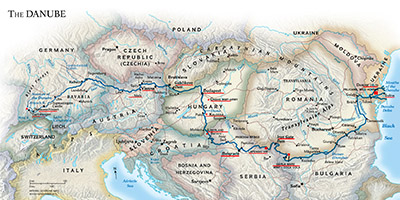
> Portfolio > The Danube
The Rebirth of a River
Symbol of Europe, the Danube river went through crises but over time and the European construction it has become a link between poor and rich countries, as well as an example of cooperation.
The river has always been a waterway for the transport of goods and that’s why in 1948 the ten riparian countries (plus Russia) decided to create the European Commission of the Danube, to ensure free, simplified and safer navigation on the river. In 1998, after the first ecological alerts, the International Commission for the Protection of the Danube River was created to ensure sustainable and equitable management of the resource, to control the risks of flooding and accidental pollution, and to reduce the amount of pollution going into the Black Sea.
The Danube river takes its source in the German Black Forest and crosses Europe from west to east over more than 3000km, passing through four capitals (Vienna, Bratislava, Budapest and Belgrade) and ten countries before forming a delta between Romania and Ukraine and flowing into the Black Sea.
9,000 years ago, the first European civilization was born in Lepenski Vir in Serbia, which already put the Danube at the heart of its beliefs with sculptures of human heads and fish bodies. Over the millennia the hordes invaded Europe before being controlled by the Roman Empire, then in the year 800 by Charlemagne, who dreamed of uniting the Rhine and the Danube by a canal. His dream came true only in the 19th century. Since then, men have continued to dike the river to fight against floods and facilitate navigation.
Thanks to the river, Europe was able to prosper and thus develop architecture, culture and art, especially music with Mozart, Strauss or Beethoven. An incredible wealth that also requires energy: a dozen dams have been built upstream of Vienna and more recent and more colossal ones downstream. The Djerdap dam in the Iron Gates gorge, which supplies electricity to Romania and Yugoslavia, is one of the largest in the world.
To build the Czechoslovakian dam of Gabcikovo and the Hungarian one of Nagymaros, both countries signed a bilateral treaty in 1977. But the Czechoslovaks diverted the waters of the Danube, drying up the entire alluvial plain downstream. Hungary, dissatisfied with the effects on the environment, refused to build the Nagymaros dam, which is essential for the smooth functioning of the Slovak dam. The two countries went to the International Court of Justice in 1993, which convicted them both of breaches under their treaty ... but the dispute remains unresolved.
Nevertheless, the Danube River still has treasures that have practically disappeared from Western Europe: alluvial plains. These natural areas populated with hundred-year-old trees are sponges that absorb floods and then release the water slowly. They are also very rich ecosystems. 80% of them have already disappeared. Fortunately, international agreements protect them. Associations from Austria, Slovenia, Croatia, Hungary and Serbia have joined forces to defend the Amazon of Europe - a 7,000 hectare wetland threatened by a succession of seven dams. An astonishing partnership has been signed between WWF and Coca Cola to protect wetlands and create green corridors along the Danube and its tributaries (Hungary, Croatia, Serbia, Romania, Bulgaria and Austria). The old marshes of the alluvial plain will be reconnected to the river, so that 5,000 hectares of this area can be flooded again (12 million m3 of water) and thus also regulate the floods of the Danube.
Like on the Mekong, the dams which retain the sediments have an immediate effect on the delta which is no longer supplied with sand. That of the Danube is retreating by ten meters per year. It still occupies an immense territory covered with reed beds that are difficult to penetrate. It is the refuge of a fishing people of Russian origin, the Lipovans, and also rare fauna, including the famous pelicans and wild horses. The delta, 2,700 km2, which hosts 150 species of fish and 300 birds, is fortunately a biosphere reserve and a World Heritage Site.
This does not prevent riparian countries from arguing. Romania accuses Ukraine of having pierced the Bystroe Canal to access the Danube directly without paying taxes. But a more serious threat hangs over this unique ecosystem: one hundred billion cubic meters of gas and ten billion tons of oil are said to be hiding under its waters.

The Danube River is 3000 km long and flows from the Black Forest in Germany through 10 countries and discharges into the Black Sea.
GEO France & GEO Slovakia
Publication Oct 2020 and Jan 2021
BONUS (in French)
-
The Liberland on GEO
- Portfolio 7/Corriere della Sera